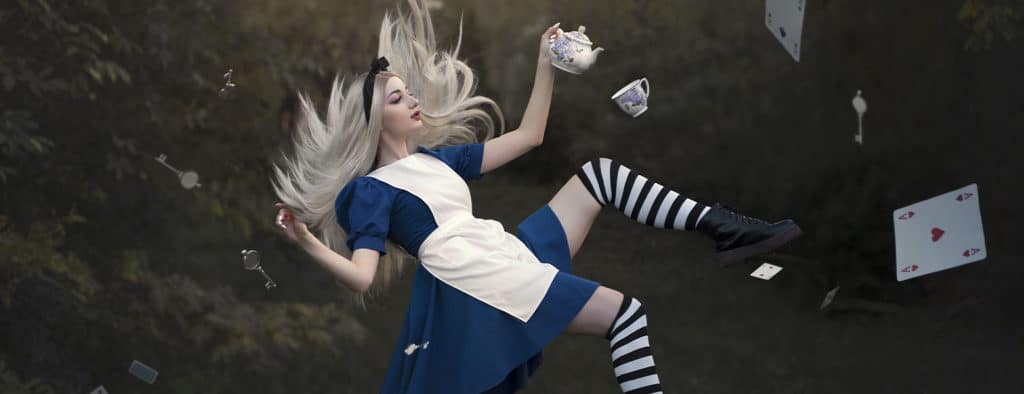6 Mental Health Conditions that Benefit From CBT
8th August 2021
We all have a pretty good idea of what mental health disorders like depression and anxiety look like. Approximately 13% of the world’s population suffer from some kind of mental disorder. That’s roughly 971 million people. But did you know there’s actually an entire spectrum of mental health disorders that are far removed from what you hear about in the mainstream they seem like the stuff fantasy?
Here are ten rare mental health disorders you never heard of…
1. Alice in Wonderland Syndrome
And in many ways, this is really drawing on the fantastical. Although it has no direct link to the actual source material, Alice in Wonderland Syndrome is very real and causes you to experience temporary episodes of distorted perception and disorientation. The name comes from the fact you may feel either larger or smaller than you really are… The room you’re in may also seem to shift and feel either closer or further away than it really is. But these aren’t hallucinations. These experiences are caused by changes in how your brain perceives your environment. And it doesn’t just affect your perception – it can and does affect multiple senses and that includes your vision, touch, and hearing. Time can also become distorted as well – either speeding up or slowing down. It tends only to affect young adults, as most people tend to grow out of it by the time they reach adulthood. Although cases still aren’t totally unheard of…
2. Erotomania
AKA de Clerambault Syndrome falls in the category of delusional disorders. In other words, it’s a form of psychosis, which, in this case, leads people to believe that a figure who isn’t in their life – and they may never even have met before – is in love with them. In many cases, this can be a public figure or celebrity. And while it is definitely the work of fantasy and infatuation with no real grounding, the people having these ‘feelings’ believe they’re absolutely real. The actual cause of the condition isn’t exactly clear, and as with all mental health disorders the way it manifests will be very circumstantial and dependent on that person’s environmental influences, current mental state and baseline personality. In the cases that have been recorded, it was discovered that erotomania isn’t a static condition. It can present by itself, but it’s also be shown to present as a symptom of more serious mental health disorders such as:
- Schizophrenia
- Major Depressive Disorder
- Bipolar
- Alzheimer’s
Some psychologists have even suggested that social media platforms such as Twitter, Instagram and YouTube can exacerbate the condition, as it breaks down the barrier between people who would otherwise be disconnected. It creates a false sense of kinship, and a sense of connection that the emotional vulnerable latch onto in their time of need. This has been backed up by several studies that suggest the attachment observed in erotomania is a form of coping mechanism for managing severe stress.
3. Alien Hand Syndrome
Now, keeping on the theme of fantasy, we’re venturing into the realms of sci-fi with this one. Alien hand syndrome is a neurological condition that causes your hand to act of its own free will. Basically, the hand acts free of the mind and will move completely independently and out of sync with what the rest of the body is trying to do. It can make the hand feel as though it’s not a part of the body and like it’s a foreign object. Hence the name… And although it can affect children, cases are mostly confined to adults. It can also be referred to as Dr Strangelone syndrome, Strangelovian hand, or archaic hand. As for how it’s caused… There are several factors at play. Some of the main causes include:
- Development as a side effect of a stroke, trauma, or tumour
- An effect of some types of cancer
- Neurodegenerative disease
- Brain aneurysms
And some of the symptoms include:
- The inability to control the hand
- The affected hand trying to perform goal-directed tasks or actions
- The hand moving without cognitive input or awareness
- Engaging in self-oppositional tasks (i.e closing a door you just opened)
- Being uncooperative with tasks that require both hands
4. Factitious Disorder
People who suffer from this condition will deliberately attempt to fabricate signs of physical illness or injury to receive medical treatment and/or care and attention within a medical setting. And that’s the goal here, there’s no practical benefit from receiving attention. It’s mainly psychological. Although in some cases, people will receive unnecessary surgeries. But that’s not to take anything away from its seriousness. Those who experience it often endure quite severe emotional difficulties and are at high risk of attempting to harm themselves so they can gain more treatment. There are two types of factitious disorder:
The first is:
- Self-imposed factious disorder:This involves falsifying psychological or physical symptoms. So for example, a person may mimic behaviour typical of let’s say schizophrenia. They’ll report all the associated signs and symptoms. But they’ll actually experience none of them.
- Factitious Disorder Imposed on another:People with this variant will produce or fabricate symptoms of those who’re under their care. So, for example, elderly people, children, or the disabled. It most often occurs in mother’s who may harm their child to gain attention.
Factitious disorder tends to affect less than 0.5% of the population.
5. Capgras Syndrome
Also known as ‘imposter syndrome’ or Capgras Delusion. People with this mental health condition believe that someone in their life that plays a significant role what been replaced with an imposter. And this inevitably leads them to accuse ‘said-person,’ whether it be a relative, friend, or co-worker of not being who they are mean to be. Again, as with erotomania, it can present as an individuated case. But it’s also been known to present as a symptom of:
- Alzheimer’s
- Dementia
- Schizophrenia
- Epilepsy
However, there’s still no agreed-upon cause of how Capgras syndrome develops. Some researchers believe it’s a neurological issue in the brain, caused by either atrophy, lesions, or cerebral dysfunction. While, on the other hand, others believe that it’s a combination of physical and cognitive changes. With yet another theory stating it’s a problem with perception linked to damaged or missing memories.
6. Apotemnophilia
And this one might send a few shivers up your spine… If you’re unfamiliar with the condition, Apotemnophilia also known as body integrity disorder or amputee identity disorder is a neurological condition. Its defining characteristic is the overwhelming desire to either amputate or damage healthy parts of the body, which can also be known as ‘self-demand amputation.’ Compared to the other mental health disorders on this list, there isn’t a great deal that’s known about it. The first known case that was reported dates back to 1933 in medical journals citing, “erotically-obsessed persons who wanted to become amputees themselves.” The firt actual scientific report only appeared in 1977. The cause is still unknown at this point, although it’s speculated that it could be a result of psychiatric etiology, which refers to a “pathological desire driven by sexual compulsion.” However, recent developments have also offered a neurological explanation, which says the condition could be the result of dysfunction within the right parietal lobe.
7. Stendhal Syndrome
The next condition is perhaps something that might be used as a gag in a sitcom. But it is, however, a very real thing. Stendhal Syndrome is describe someone who experiences
- Physical and or emotional anxiety,
- Panic attacks,
- Dissociate experiences
- Hallucinations
When exposed to art… But not just any art… The symptoms are most often triggers by “art that is perceived as particularly beautiful or when the individual is exposed to large quantities of art that are concentrated in a single place.” So for that, read:
- Museums
- Gallerys
- Exhibitions
Surprisingly, the syndrome has a fairly long history and was first coined in 1989 by an Italian psychiatrist, although reports of artwork causing distress date all the way back to the 1800s.
8. Visual Snow Syndrome
Also, known as visual static or persistent positive visual phenomena. It describes a condition that will cause you to see continuous flickering white dots within your entire field of vision. These are the snow or static we just mentioned. These dots are usually blank and white, but also present as flashing, colour or even transparent.
The visual symptoms include:
- Floaters
- Flashes of light
- Compromised night vision
- Colour swirls
- A consistent imprinted image
- Sensitivity to light.
And then there’s alas a non-visual set of symptoms, which include:
- Migraines
- Tinnitus (Ringing in the ears)
- Vertigo
- Fatigue
- Tremors
- Anxiety
- Depression
No one is entirely certain how this condition develops, but the best research done so far, indicates it’s perhaps a complex neurological condition. As for recorded cases, there isn’t a great deal of information with it being such a new diagnosis. And to date, there have only been around 200 cases worldwide
9. Folie a Deux
Folie a Deux is almost like something from a supernatural thriller. Also known as shared delusion or shared psychotic disorder, it occurs when an otherwise mental stable person takes on the symptoms of someone close to them who’s suffering from a psychotics disorder such as schizophrenia. For example, let’s say your partner has a psychotic disorder, which causes her to think that she’s being haunted by ghosts. If you have shared decisional disorder, you too will believe that you’re also being haunted by ghosts. However, the condition only tends to occur in long-term relationships in which the person with the psychotic disorder is dominant and the other partner is passive.
Shared psychotic disorders have also been known to happen in groups where there’s close involvement with a psychotic person. This variant is called folie a plusiers or the ‘the madness of many.’ An example of this would be if a cult leader happened to be psychotic, his followers may then take on his/her delusions.
10. Reduplicative Amnesia
Reduplicative Amnesia is very similar to Capgras syndrome. But in this case, instead of believing that people have been replaced with doubles, in those with Reduplicative Amnesia, they believe that their entire location has been duplicated. The way this manifests can vary, and it’s often been attributed to severe head trauma that creates a dissociate-type effect between the individual and their environment. The condition was first documented back in 1903 by psychiatrist Arnold Pick, with a patient with suspected Alzheimer’s. The woman in question insisted that she’d been moved from Pick’s city clinic to one that was identical but located in a familiar suburb. Today, the condition is sometimes observed in people who may be suffering from:
- Alzheimer’s
- Brain Tumours
- Dementia
- Brian Injury
- Psychiatric disorders














